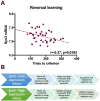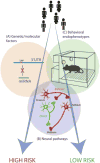Shaping vulnerability to addiction - the contribution of behavior, neural circuits and molecular mechanisms
- PMID: 28571877
- PMCID: PMC5708151
- DOI: 10.1016/j.neubiorev.2017.05.019
Shaping vulnerability to addiction - the contribution of behavior, neural circuits and molecular mechanisms
Abstract
Substance use disorders continue to impose increasing medical, financial and emotional burdens on society in the form of morbidity and overdose, family disintegration, loss of employment and crime, while advances in prevention and treatment options remain limited. Importantly, not all individuals exposed to abused substances effectively develop the disease. Genetic factors play a significant role in determining addiction vulnerability and interactions between innate predisposition, environmental factors and personal experiences are also critical. Thus, understanding individual differences that contribute to the initiation of substance use as well as on long-term maladaptations driving compulsive drug use and relapse propensity is of critical importance to reduce this devastating disorder. In this paper, we discuss current topics in the field of addiction regarding individual vulnerability related to behavioral endophenotypes, neural circuits, as well as genetics and epigenetic mechanisms. Expanded knowledge of these factors is of importance to improve and personalize prevention and treatment interventions in the future.
Keywords: Dopamine D2 receptor; Drug abuse; Endophenotypes; Epigenetics; Genetics; Prodynorphin; Striatum.
Copyright © 2017 Elsevier Ltd. All rights reserved.
Figures




Similar articles
-
Neuroscience of resilience and vulnerability for addiction medicine: From genes to behavior.Prog Brain Res. 2016;223:3-18. doi: 10.1016/bs.pbr.2015.09.004. Epub 2015 Nov 23. Prog Brain Res. 2016. PMID: 26806768 Review.
-
Epigenetics of drug abuse: predisposition or response.Pharmacogenomics. 2012 Jul;13(10):1149-60. doi: 10.2217/pgs.12.94. Pharmacogenomics. 2012. PMID: 22909205 Free PMC article. Review.
-
Drugs of abuse: epigenetic mechanisms in toxicity and addiction.Curr Med Chem. 2011;18(12):1765-74. doi: 10.2174/092986711795496836. Curr Med Chem. 2011. PMID: 21466474
-
Drugs and addiction: an introduction to epigenetics.Addiction. 2011 Mar;106(3):480-9. doi: 10.1111/j.1360-0443.2010.03321.x. Addiction. 2011. PMID: 21205049 Review.
-
In search of predictive endophenotypes in addiction: insights from preclinical research.Genes Brain Behav. 2016 Jan;15(1):74-88. doi: 10.1111/gbb.12265. Epub 2015 Nov 13. Genes Brain Behav. 2016. PMID: 26482647 Review.
Cited by
-
Reconciling Competence and Consent in Opioid-Dependence Research: The Value of Vulnerability Rhetoric.Am J Bioeth. 2017 Dec;17(12):48-50. doi: 10.1080/15265161.2017.1388871. Am J Bioeth. 2017. PMID: 29148934 Free PMC article. No abstract available.
-
tRNA epitranscriptomic alterations associated with opioid-induced reward-seeking and long-term opioid withdrawal in male mice.Neuropsychopharmacology. 2024 Jul;49(8):1276-1284. doi: 10.1038/s41386-024-01813-6. Epub 2024 Feb 8. Neuropsychopharmacology. 2024. PMID: 38332016 Free PMC article.
-
Inter-Individual Differences in Cognitive Tasks: Focusing on the Shaping of Decision-Making Strategies.Front Behav Neurosci. 2022 Mar 29;16:818746. doi: 10.3389/fnbeh.2022.818746. eCollection 2022. Front Behav Neurosci. 2022. PMID: 35431831 Free PMC article. Review.
-
Addiction vulnerability and the processing of significant cues: Sign-, but not goal-, tracker perceptual sensitivity relies on cue salience.Behav Neurosci. 2020 Apr;134(2):133-143. doi: 10.1037/bne0000353. Epub 2020 Jan 9. Behav Neurosci. 2020. PMID: 31916796 Free PMC article.
-
Epigenetic Mechanisms Mediate Nicotine-Induced Reward and Behaviour in Zebrafish.Curr Neuropharmacol. 2022 Mar 4;20(3):510-523. doi: 10.2174/1570159X19666210716112351. Curr Neuropharmacol. 2022. PMID: 34279203 Free PMC article.
References
-
- Abler B, Walter H, Erk S, Kammerer H, Spitzer M. Prediction error as a linear function of reward probability is coded in human nucleus accumbens. Neuroimage. 2006;31:790–795. - PubMed
-
- Albin RL, Young AB, Penney JB. The functional anatomy of basal ganglia disorders. Trends Neurosci. 1989;12:366–375. - PubMed
-
- Alexander GE, Crutcher MD. Functional architecture of basal ganglia circuits: neural substrates of parallel processing. Trends Neurosci. 1990;13:266–271. - PubMed
-
- Ambros V. The functions of animal microRNAs. Nature. 2004;431:350–355. - PubMed
-
- Anker JJ, Zlebnik NE, Gliddon LA, Carroll ME. Performance under a Go/No-go task in rats selected for high and low impulsivity with a delay-discounting procedure. Behav Pharmacol. 2009;20:406–414. - PubMed
Publication types
MeSH terms
Grants and funding
LinkOut - more resources
Full Text Sources
Other Literature Sources
Medical

